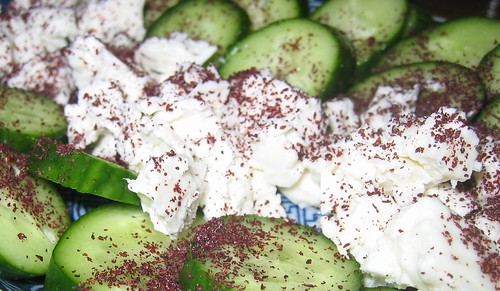
Remember those car games you used to play as a child? You'd pick something, briefly describe it, and your just-as-bored sibling would try and figure out what you found on the horizon?
"I spy something red!"
"The sumac bushes!"
Often seen on roadsides, sumac is one of those plants we always believed to be poisonous (No, Johnny do not put that in your mouth!), but there are actually edible and delicious varieties. Just to get a little geeky horticulturalist on you, there are about 250 species in the genus Rhus. With some species, the dried berries are ground into a fine tangy-lemony tasting powder. This deep garnet-colored spice is the non-poisonous one we, fortunately, can eat. And, if you're looking to re-landscape your yard, one landscaper has rated sumac as one of the best 5 shrubs for fall colors. How's that for versatility?
In the Middle East sumac is as much of an essential ingredient as vinegar or lemon juice is in the West. Always on the hunt for something new to dress a salad, I tried it and I'm hooked. Not only does it awaken your food with a colorful dash of deep purple, but it adds a wonderful tart flavor, yet much less pungent than lemon.
This tart-fruity spice is wonderful dusted on meats, fish, chicken, or simply on rice and veggies. Try sprinkling a bit of sumac on top of Persian cucumbers with feta or plain yogurt for a delicious side dish.











Comments
April 3, 2008
I'm excited to start checking into this sumac stuff!
June 26, 2008
I live in Lebanon and down here we have lots and lots of Sumac!
You shuold all try it on salads.
Sometimes for just serving some appetizers you can slice some tomatoes and sprinkle some salt, pinch of lemon, olive oil and sumac.
Try it, you won't regret it!
September 6, 2008
I've got sumac in my zatar mixture, but I've not tried sumac on its own. Now I'm going to keep my eyes open for this.